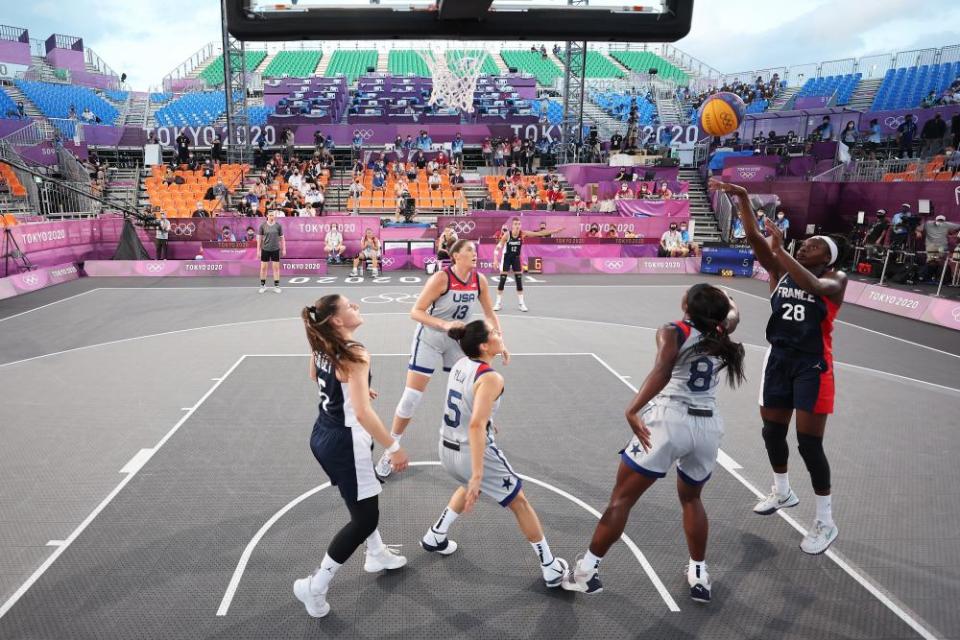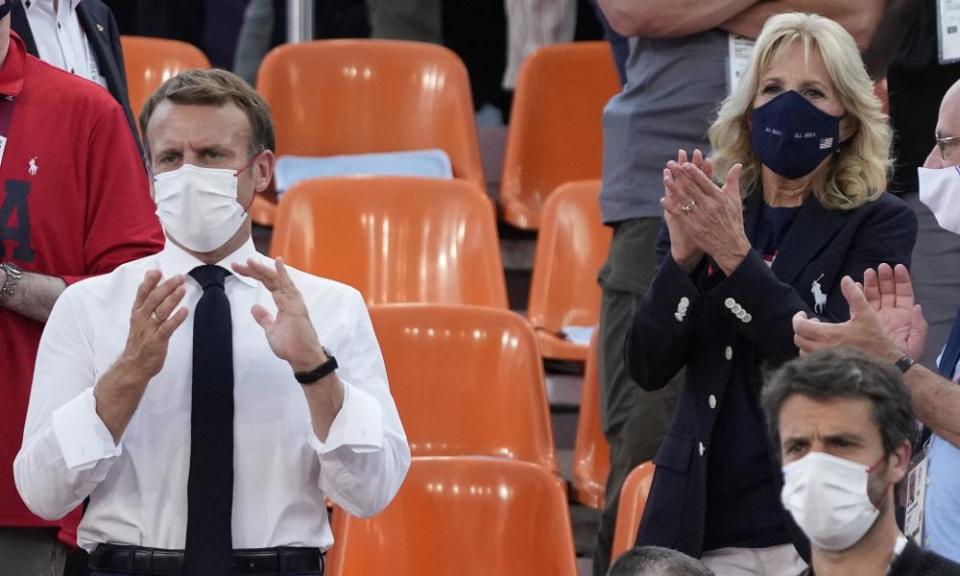End-to-same-end stuff as 3x3 basketball makes Olympic debut

- Oops!Something went wrong.Please try again later.
- Oops!Something went wrong.Please try again later.
In the before times, when “urban cluster” was a phrase that meant something very different at the Tokyo Olympics, 3x3 basketball was poised to make some noise in its Games debut. It still did on Saturday – after all, DJs play music during contests to pump up the atmosphere. But while the world has grown used to sports taking place behind closed doors during the pandemic, there may be an especially keen sense of loss at the Ariake and Aomi urban sports parks in the next fortnight.
They were designed with mingling in mind, envisioned as the throbbing heart of an outdoor sporting carnival zone that, organisers promised in 2019, would deliver “a buzzing festival environment that brings fans closer to the Olympic action than ever before”.
Related: Olympics 2020: Team GB beat Japan in football, plus swimming – live!
Fans were to be permitted to ride or skate the actual courses and play pick-up games, with ticketless visitors welcome to hang out. Where better for the Olympics to introduce new city-centric events than the world’s most populous metropolitan area, home to 38 million people?
Now, with spectators barred, clusters are a matter for epidemiologists and the venues are not so much hopping as Edward Hopper: studies in urban isolation. What was planned as a celebration of youthful dynamism is a sequestered symbol of emptiness and exclusion.
Not that the seats were entirely unoccupied when the United States women’s team faced France, with a smattering of masked onlookers providing polite applause, including two notable traveling fans: Emmanuel Macron and Jill Biden.
“As soon as we walked out, we saw her in the stands,” the US player Kelsey Plum said of the first lady following a comfortable 17-10 win for the Americans against a highly rated French team. “She waved and she brought all the energy so we are grateful for that.”
Macron leaned over a railing to talk with the French players after the game. “We all hope there will be more atmosphere in Paris,” the president told L’Equipe. “If we’d been told two years ago that the Olympics would take place in these conditions, no one would have believed it.” The French capital hosts the Olympics in 2024.

Social distancing is especially incongruous with the convivial ethos of urban lifestyle-inspired sports such as 3x3. It’s an event where talk of finding the right rhythm can refer as easily to tunes as tactics. Italy’s top female player, Rae Lin D’Alie – who hails from Wisconsin and is known as “Rae Rae” – recorded the sport’s official hip-hop anthem. The US and France racked up early points to the sound of Get Lucky by Daft Punk.
Skateboarding, sport climbing and surfing are also new at these Olympics, along with karate. “We want to take sport to the youth,” the International Olympic Committee (IOC) president, Thomas Bach, said in 2016. “With the many options that young people have, we cannot expect any more that they will come automatically to us. We have to go to them.” Last December the IOC announced that breakdancing will be added to the programme for 2024.
Though the restrictions represent a grievous blow to organizers’ hopes of engaging a youthful audience, the 3x3 action promises to be intense and irreverent, with the world’s best male player, Serbia’s Dusan Bulut, capable of outrageous trickery.
The discipline is organic with genetically modified components: born from impromptu street battles, its rapid growth carefully nurtured by Fiba, basketball’s international governing body. Introduced to the Youth Olympic Games in Singapore in 2010, it joined the international calendar in 2012 with a 3x3 world championships and World Tour and Fiba set up an online community and rating system.

The men’s and women’s Olympic 3x3 tournaments each comprise eight teams, with the medals decided on 28 July. Games are held on a half-court, with the team in the lead after 10 minutes or the first to reach 21 points the winner. Successful close-range shots garner one point, while those outside the arc are worth two. The ball is slightly smaller than in the 5x5 game to promote snappier handling, there’s a 12-second shot clock, one substitute per team, and in-game coaching is not allowed. With only one hoop and a frantic pace, it is end-to-same-end stuff.
“It is a quick game and you have to be ready to play from the start, and we impress upon our players that we want to play as fast as we can and know that nothing is ever safe,” Kara Lawson, the US coach, said. “There might be two minutes left and you might be in the lead and there are so many possessions that it can vanish pretty quickly. Urgency is important on both sides of the ball.”
Another key difference from the traditional format is that the US are not all-conquering. A men’s team without active NBA players did not even reach Tokyo, losing to the Netherlands in the quarter-finals of the qualifying tournament. Serbia and Latvia are the men’s favourites in Japan.
The US can call on a roster of WNBA players but suffered a setback a couple of days before the tournament when Katie Lou Samuelson of the Seattle Storm had to withdraw after contracting Covid-19. Still, they cruised through their second match of the evening, dispatching Mongolia 21-9 in only seven minutes on a night of thumping beats and empty seats.

